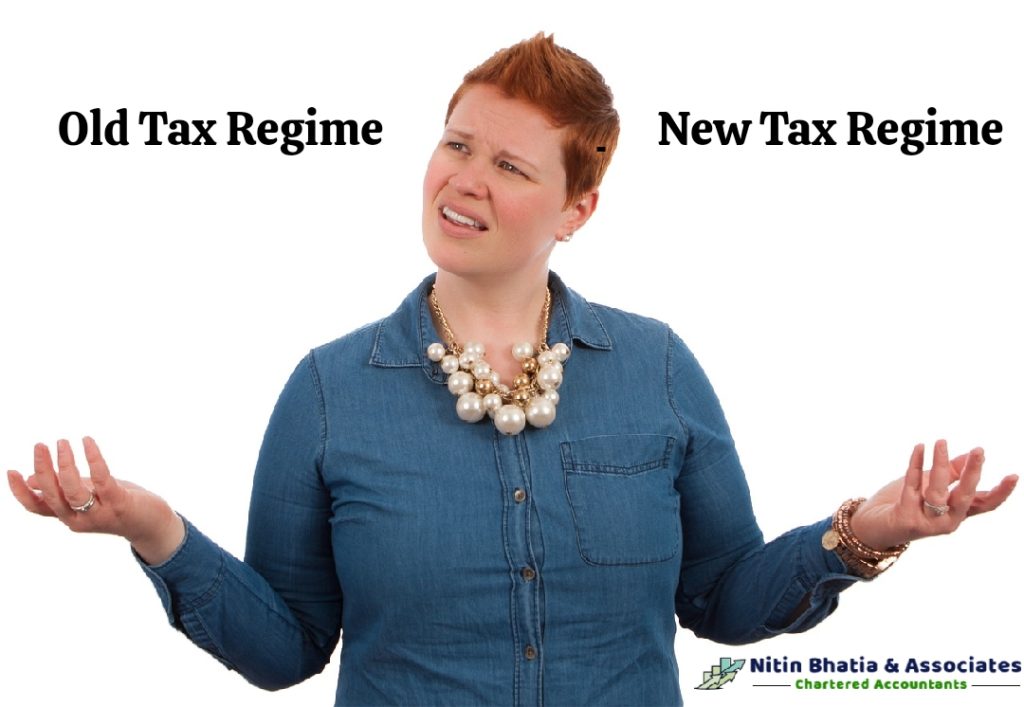As the new financial year has begun, taxpayers are faced with a critical decision – whether to opt for the old tax regime or the new tax regime. This decision has become all the more important as the government has made some significant changes to the tax regime in the previous year, and taxpayers must understand the implications of each option before making a choice. Choosing between the two can be a tricky decision, and it’s important to understand the differences between them to make an informed decision.
This blog will assist you in determining which tax regime will be advantageous for you, enabling you to save a significant amount on taxes. So, don’t fret, as this write-up will guide you towards making an informed decision.

a) Why is it necessary to choose a Tax Regime?
As per Circular No. 04/2023 issued by the Central Board of Direct Taxes (CBDT), employers are now mandated to seek information from their employees regarding their preferred tax regime. This means that employees must select either the old or new tax regime and inform their employer accordingly. Once the employee has made a choice, the employer will deduct TDS (Tax Deducted at Source) accordingly.
In case you do not make a choice between the New and Old Tax Regime, your employer will consider the New Tax Regime as the default option and deduct TDS accordingly. This could result in a higher TDS deduction for you.
However, it is important to note that you can still switch to the Old Tax Regime while filing your Income Tax Return (ITR) and claim deductions and exemptions, if applicable. Therefore, it is advisable to choose the Tax Regime that is most beneficial for you and inform your employer to avoid any inconvenience later on.

b) The Tax Slabs for Old and New Regimes are:
Old Regime
- Income up to 2.5 Lakhs – Nil
- Income between 2.5 Lakhs – 5 Lakhs – 5%
- Income between 5 Lakhs – 10 Lakhs – 20%
- Income above 10 Lakhs – 30%
New Regime
- Income up to 3 Lakhs – Nil
- Income between 3 Lakhs – 6 Lakhs – 5%
- Income between 6 Lakhs – 9 Lakhs – 10%
- Income between 9 Lakhs – 12 Lakhs – 15%
- Income between 12 Lakhs – 15 Lakhs – 20%
- Income above 15 Lakhs – 30%
c) Deductions and Exemptions available under the Old Tax Regime
Here are the deductions and exemptions available under the Old Tax Regime:
- Investments made under Section 80C (such as PPF, Tuition fee, ELSS, EPF, ULIP, Tax Saver Fixed Deposits, Life Insurance Premium, Home Loan Principal, NPS etc.).
- House Rent Allowance.
- Leave Travel Allowance.
- Leave Encashment.
- Home Loan Interest Payment.
- Health Insurance Premiums and expenses on medical treatment under section 80D
- Treatment of self or dependent for a specified disease.
- Contribution of employer and employee to NPS.
- Interest paid on Education Loan.
- Donation to specified institutions for the disability of self.
- Reimbursements of expenses which are part of special allowance
- Standard deduction of Rs.50,000
Deductions and Exemptions available under the New Tax Regime
- Deduction towards Employer’s Contribution to NPS.
- Expenses towards earnings from Family Pension up to 15,000.
- Standard deduction of up to 30 percent of the annual value of the let-out property, in case of rental income from property.
- Standard deduction of Rs.50,000
- Exemption on Voluntary Retirement 10(10C), Gratuity u/s 10(10), and Leave Encashment u/s 10(10AA).
- Amount paid or deposited in the Agniveer Corpus Fund.
- Interest and maturity proceeds from schemes such as Public Provident Fund (PPF) and Sukanya Samriddhi account and Life Insurance Policies remain Tax-Exempt under the New Regime.
d) Which Tax Regime to Select?
a) When Income is 7 Lakhs
If your income is up to Rs 7 lakh, then the New Tax Regime will benefit you because there is no tax liability on the income of Rs. 7 Lakhs.
b) When Income is more than Rs.15 Lakhs
It is important to note that to determine which tax regime is more advantageous, you need to calculate your eligible deductions. If your income exceeds Rs.15.50 lakhs and your total deductions (as outlined in the “Deductions and Exemptions available under the Old Tax Regime”) are greater than Rs. 425,000, then the old tax regime will be more beneficial. Conversely, if your deductions are less than Rs. 425,000, the new tax regime will be more advantageous. It’s important to note this distinction.
e) Income tax Calculator:
Here’s a link to an income tax calculator that can help you determine which regime would be more beneficial for you, how much tax you would pay, and which regime would provide more benefits.
https://incometaxindia.gov.in/Pages/tools/115bac-tax-calculator-finance-bill-2023.aspx
f) Important Suggestions
Choosing the right tax regime can have a significant impact on your tax liability, and it’s important to consider all the available options before making a decision.
Here are some tips to help you choose the right tax regime for you:
- If your income is up to Rs 7 lakh, then the New Tax Regime might be better for you. This is because the new tax regime has lower tax rates for incomes up to Rs 15 lakh, which could result in lower tax liability for you.
- If you don’t have any tax savings or deductions to avail of, then you should consider going for the New Tax Regime. This is because the new tax regime has a simple tax structure and doesn’t require you to invest in specific tax-saving instruments.
- If you have only 80C deductions of up to Rs 1.5 lakh, then the New Tax Regime might be better for you. This is because the new tax regime has a higher basic exemption limit and lower tax rates, which could result in lower tax liability for you.
- If you can avail of 80C deductions and also have a home loan, then the Old Tax Regime might be better for you. This is because the old tax regime allows you to claim deductions for both home loan interest payments and principal repayments under Section 80C.
- If you have an HRA deduction to claim, then the Old Tax Regime might be better for you. This is because the old tax regime allows you to claim HRA deductions along with other deductions, which could result in lower tax liability for you.
- Lastly, if you have an HRA Deduction to claim, the Old Tax Regime might be better for you. This is because the HRA deduction is not available in the New Tax Regime.
g) Comparison of Tax Deductions and Exemptions Available in the New and Old Tax Regimes
Here’s a comparison chart of the deductions and exemptions available under the new and old tax regime:
| Particulars | New Tax Regime | Old Tax Regime |
| Income level for rebate eligibility | 7 lakhs | 5 lakhs |
| Standard Deduction | 50,000 | 50,000 |
| Effective Tax-Free Salary income | 7.5 lakhs | 5.5 lakhs |
| Rebate u/s 87A (Max Amount) | 25,000 | 12,500 |
| Allowable Exemptions | ||
| HRA Exemption [Section 10(13A)] | X | ✓ |
| Leave Travel Allowance (LTA) 10(10AA) | X | ✓ |
| Exemption on Leave Encashment | ✓ | ✓ |
| Exemption of perquisites in respect of free foods and non alcoholic beverages [Section 17(2)] | ||
| Exemption on voluntary retirement | ✓ | ✓ |
| Exemption on gratuity u/s 10(10) | ✓ | ✓ |
| Exemption on commutation pension u/s 10(10A) | ✓ | ✓ |
| Exemption on sum received under a life insurance policy u/s 10(10D) | ✓ | ✓ |
| Exemption on interest and withdrawal from recognized provident fund u/s 10(12) | ✓ | ✓ |
| Exemption pertaining to payment from NPS u/s 10(12A)/(12B) | ✓ | ✓ |
| Professional Tax [Section 16(iii)] | ✓ | ✓ |
| Interest on Home Loan u/s 24b on self- occupied or vacant property | ✓ | ✓ |
| Interest on Home Loan u/s 24b on let-out property | ✓ | ✓ |
| Standard deduction in case of family pension [Section 57(iia)] | ||
| Deductions Under Chapter VI- A | ||
| Deduction u/s 80C 80C (such as PPF, Tuition fee, ELSS, EPF, ULIP, Tax Saver Fixed Deposits, Life Insurance Premium, Home Loan Principal, NPS etc.) | X | ✓ |
| National Pension System (NPS) Self Contribution u/s 80CCD(1B) | X | ✓ |
| National Pension System (NPS) Self Contribution u/s 80CCD (2) | ✓ | ✓ |
| Medical insurance premium- Under Section 80D | X | ✓ |
| Interest on education loan – Under Section 80E | X | ✓ |
| Interest on Electric vehicle loan – Under Section 80EEB | X | ✓ |
| Donation to Political party/trust- Under Section 80G | X | ✓ |
| Savings Bank Interest u/s 80TTA and 80TTB | X | ✓ |
| Disabled Individual – 80U | X | ✓ |
Note: In the chart, X is used to indicate that a deduction or exemption is not available, while ✓ is used to indicate that it is available.
In summary, while both tax regimes offer deductions and exemptions, the specific details vary. It’s important to carefully consider these details and choose the tax regime that is most beneficial for your specific situation.
If you still have any confusion about the new or old tax regime after reading this article, feel free to contact us. Our team can assist you in selecting the most suitable regime to save on taxes.







